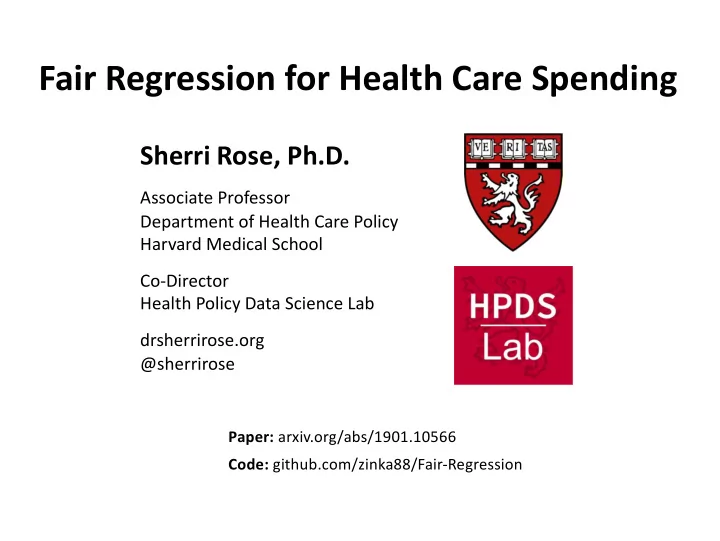

Fair Regression for Health Care Spending Sherri Rose, Ph.D. Associate Professor Department of Health Care Policy Harvard Medical School Co-Director Health Policy Data Science Lab drsherrirose.org @sherrirose Paper: arxiv.org/abs/1901.10566 Code: github.com/zinka88/Fair-Regression
Plan Payment Risk Adjustment Over 50 million people in the United States currently enrolled in an insurance program that uses risk adjustment ◮ Redistribute funds based on health ◮ Encourage competition based on efficiency and quality ◮ Massive financial implications
Plan Payment Risk Adjustment Over 50 million people in the United States currently enrolled in an insurance program that uses risk adjustment ◮ Redistribute funds based on health ◮ Encourage competition based on efficiency and quality ◮ Massive financial implications Y = θ X
Plan Payment Risk Adjustment Over 50 million people in the United States currently enrolled in an insurance program that uses risk adjustment ◮ Redistribute funds based on health ◮ Encourage competition based on efficiency and quality ◮ Massive financial implications Spending outcome Y = θ X
Plan Payment Risk Adjustment Over 50 million people in the United States currently enrolled in an insurance program that uses risk adjustment ◮ Redistribute funds based on health ◮ Encourage competition based on efficiency and quality ◮ Massive financial implications Spending outcome Y = θ X Input vector
Plan Payment Risk Adjustment Over 50 million people in the United States currently enrolled in an insurance program that uses risk adjustment ◮ Redistribute funds based on health ◮ Encourage competition based on efficiency and quality ◮ Massive financial implications Spending outcome Y = θ X Coefficient vector Input vector
Improving Mental Health Care, 1950-2000 Changes in financing and organization of mental health care, not new treatment technologies, made the difference “Improvements ... evolved through ... more money, greater consumer choice, and the increased competition among ... providers that these forces unleashed”
Mental Health and Substance Use Disorders (MHSUD) Risk adjustment in the Marketplaces recognizes only 20% of enrollees with MHSUD Individuals with MHSUD can be systematically discriminated against
Algorithmic Fairness Typical algorithmic fairness problem in computer science has ◮ outcome Y ◮ vector X that includes a protected class or sensitive attribute A ⊂ X Goal: Create estimator for f ( X ) = Y while ensuring the function is fair for A Common measures of fairness are based on the notion of group fairness , striving for similarity in predicted outcomes or errors for groups
Can we improve fairness for undercompensated groups in plan payment risk adjustment?
Can we improve fairness for undercompensated groups in plan payment risk adjustment? Challenges: ◮ Current formulas created with parametric regression without built-in fairness criteria ◮ Much of the fairness literature considers binary decision-making
Fairness for Risk Adjustment
Fairness for Risk Adjustment Data transformations Health Economics Computer Science & Statistics Newhouse (2002) Kamiran and Calders (2009) Layton et al. (2016) Zliobaite et al. (2011) Bergquist et al. (2018) Zemel et al. (2013) Calmon et al. (2017) Johndrow and Lum (2017)
Fairness for Risk Adjustment Adding variables, separate formulas, statistical learning Health Economics Computer Science & Statistics van Kleef et al. (2013) Kamishima et al. (2012) Rose (2016) Berk et al. (2017) van Kleef et al. (2017) Zafar et al. (2017a,b) Shrestha et al. (2018) Bechavod and Ligett (2018) van Kleef et al. (2018) Dwork et al. (2018)
Fairness for Risk Adjustment Reinsurance, differing thresholds Health Economics Computer Science & Statistics e.g., McGuire et al. (2018) Bansal et al. (2014) Hardt et al. (2016) Kleinberg et al. (2018) El Mhamdi et al. (2018)
Global vs. Group Fit Group undercompensation is a result of large residuals in the risk adjustment formula; we define fairness as a function of these residuals
Global vs. Group Fit Group undercompensation is a result of large residuals in the risk adjustment formula; we define fairness as a function of these residuals
Global vs. Group Fit Demonstration (Rose & McGuire 2019)
Global vs. Group Fit Demonstration (Rose & McGuire 2019)
Global vs. Group Fit Demonstration (Rose & McGuire 2019)
Global vs. Group Fit Demonstration (Rose & McGuire 2019)
Global vs. Group Fit Demonstration (Rose & McGuire 2019)
Global vs. Group Fit Demonstration (Rose & McGuire 2019)
Global vs. Group Fit Demonstration (Rose & McGuire 2019)
Global vs. Group Fit Demonstration (Rose & McGuire 2019)
Global vs. Group Fit Demonstration (Rose & McGuire 2019)
Global vs. Group Fit Demonstration (Rose & McGuire 2019)
Global vs. Group Fit Demonstration (Rose & McGuire 2019)
Global vs. Group Fit Demonstration (Rose & McGuire 2019)
Global vs. Group Fit Demonstration (Rose & McGuire 2019)
Can we improve fairness for undercompensated groups in plan payment risk adjustment? Overview of Contributions: ◮ Develop new statistical machine learning methods for group fairness with continuous outcomes ◮ Propose new evaluation metrics for group fairness with continuous outcomes ◮ Demonstrate techniques in plan payment risk adjustment and simulation settings
Large Gains in Group Fairness vs. OLS (Zink & Rose 2019)
Large Gains in Group Fairness vs. OLS (Zink & Rose 2019)
Large Gains in Group Fairness vs. OLS (Zink & Rose 2019)
Large Gains in Group Fairness vs. OLS (Zink & Rose 2019)
Large Gains in Group Fairness vs. OLS (Zink & Rose 2019)
Large Gains in Group Fairness vs. OLS (Zink & Rose 2019)
Future Directions ◮ Multiple groups and detection of new groups
Future Directions ◮ Multiple groups and detection of new groups ◮ Integration with approaches from pre- and postprocessing phase ◮ Evaluating social impact of fair regression if deployed
Does Your Algorithm Have a Social Impact Statement? “In both private enterprise and the public sector, research must be reflective of the society we’re serving.”
Recommend
More recommend